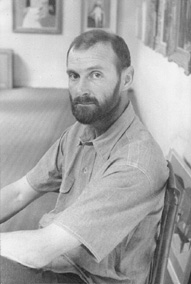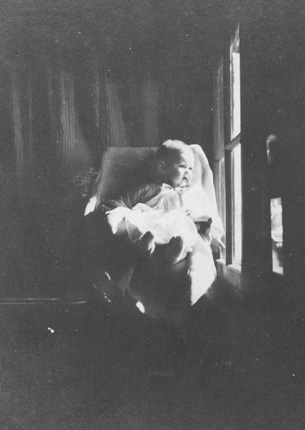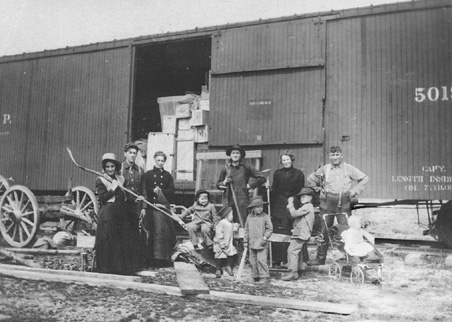

by Wally Graves
Morris Graves in Dublin, late 1950s.
THE PAINTER MORRIS GRAVES, my brother, has lived in the woods back of Loleta for 32 years -- a fact which our mother, were she alive today, would not take kindly to."California" in the days of our youth in Seattle meant noisy rich people wearing sun glasses and Hawaiian shirts flying north like mallards in their pink Cadillacs to enjoy the summer, only to flee south in bad weather.
Or, in the words of current Seattle Seahawks owner Ken Behring, "I am a rich California developer -- three bad words." (We sophisticates on the North Coast, of course, know better. These birds are "Southern Californians.")
Our mother had already been bummed out by what she called the "horrible mistake" that Morris -- alone of her eight children -- had been born not in Seattle, Wash., but in a barren valley in Eastern Oregon known as Fox; and that with his growing fame as a "visionary artist" pre-eminent in the Northwest School he was from the beginning referred to as an "Oregon" artist.
Our mother was born in a little white house on the corner of Seattle's now downtown, Second and Cherry. She was raised to the scent of salt air and smoke from sawmills, to the tooting of sea traffic, and to the cooling, moist breezes alien to eastern Oregon. A town much like Eureka, and founded just two years after Eureka, in 1852.
What happened was that in April 1910, when Mother was five months along with Morris -- her sixth child in seven years -- the romance of the new Homestead Act had caused our father to abruptly uproot a combined clan of grandmother and aunts and uncles to claim a square mile of Fox Valley ranch land. He planned to breed horses from a Percheron stud named Midnight which had caught our father's eye at Seattle's 1909 World's Fair.
Morris's birth was reported in a weekly Republican newspaper, Oregon's Long Creek Ranger, some 23 miles distant from Fox: "A bouncing baby girl was born to Mr. and Mrs. E. L. Gray, of Fox, Sunday."

Baby Morris, 1910, in the Fox Valley homestead.
The Ranger got the day right, though it skewed the sex as well as the parents who, in fact, were Mr. and Mrs. E. L. Graves. The doctor arrived by buggy from Long Creek too late for the birth. He probably never unswaddled the babe.
Mother didn't like talking about Fox, but over the years I pressed her. Morris was born in her mother's shanty, she recalled. "Grandmother's homestead joined ours but her house was more than a quarter of a mile over the hill. He was born at 6 in the morning, and weighed 7 pounds and 8 ounces. Dad's sister in Seattle sent a pink blanket with little white dogs on it. All the baby things we'd taken to Fox were pink, because -- after five boys -- we were sure Morris would be a girl."
Mother remembered how Dad led the boys -- Lyman, 7, Robert, 5, Philip, 4, Donald, 3, and Russell, 1-1/2 -- to Grandma's house to see the new baby. "Dad carried Russell in a washtub on his shoulder."
There were two groups in Fox Valley, she said: "the old settlers who had lived on the edges for many many years and used the valley for grazing their cattle -- and the new settlers -- the people who had come homesteading and broke up the area by fencing their land. The feeling was very bitter so we kept pretty much to ourselves. I don't remember being in more than two houses all the time we were there."
The earlier settlers called the land where our family homesteaded "sand hills." The soil was pale, the water scarce, and no trees shielded the family from the wind. Mother's vegetable garden fizzled. Meat from Seattle molded in a faulty root cellar. From an old settler Dad bought a cantankerous cow named Mabel.
Nobody could milk Mabel, so the family drank Carnation canned milk, and ate corned beef and boiled beans. Mother's hats and high-button shoes lay on a shelf that gathered dust, and when she wasn't boiling water, or soaking beans, or scrubbing clothes over a washboard, she sat with Grandma, in their black, full-length dresses, on two straightback chairs staring across the valley where heat waves made the trail they'd traced from Seattle squiggly and vague.
"The wind never ceased," she told me "From 10 in the morning until sundown it blew madly. In the summer dust silted everything -- and in the winter sub-zero wind that was so cold we could do nothing to get warm -- and every day of the year it blew -- blew -- blew. I have never seen wind blow so hard.
 The Seattle homesteaders at Heppner, Ore. railhead. Aunts, uncles and Morris' parents (in center); the other brothers, left to right: Donald, Philip, Robert, Lyman, Russell. (1910)
The Seattle homesteaders at Heppner, Ore. railhead. Aunts, uncles and Morris' parents (in center); the other brothers, left to right: Donald, Philip, Robert, Lyman, Russell. (1910)
"That winter Morris fell ill with pneumonia and we were too far from a doctor. Our house was full of cracks and we had to be very careful for him. Dad was gone most of the time managing his store in Seattle. Lyman kept the woodbox full and I kept fires night and day, but even then the milk sometimes froze in the baby bottle. I was unable to nurse any of you children. It snowed before Thanksgiving and stayed until the first of May in shady places.
"Morris was too young and too frail to be taken out of the house, but in the spring we did gather flowers and agates. There were beautiful mountain flowers -- Lewisia and Clarksia -- named for Lewis and Clark -- and lovely wild blue irises along a stream, and fields of dogtoothed violets -- the only time I saw them yellow.
"I wonder sometimes if that wasn't where Morris first got his love for flowers. He was a beautiful baby -- big brown eyes and dark hair, with a little faraway look in his eye -- and very friendly. We named him after Morris Cole, our favorite minister.
"We had hoped for a daughter and I'd taken quite a lot of pink material to sew for 'her.' So Morris wore pink rompers his first year. But he was happy and pink was very becoming."
She wrote in Morris's baby book that he first laughed on Oct. 3; his first tooth appeared on Jan. 17, 1911; and his first word the following September was "See." By then the family had returned to Seattle. The adventure had bankrupted our father's thriving paint and wallpaper store, taking with it our Seattle home. The Oregon homestead lay abandoned.
All this she told me years later. Fox was never part of my world. I was born a decade after.
But in the early 1970s my curiosity took me there one early morning.
Our homestead lay two miles west of the present Highway 395. Elevation 4,300 feet. In their day they'd wagoned over a dirt road some 80 miles south from the railroad at Heppner.
In a pre-dawn bronze twilight, guided by maps from the county courthouse in John Day, I was serenaded by the distant yowl of brown coyotes. I startled whitetailed jackrabbits, ground squirrels, and was alerted to nearby red foxes and white faced badgers.
Among the sparse yellowed sagebrush and pollened goldenrod on a meagre alkaline rise lay the rectangular imprint of the family's house, and Grandma's. The handle of a crushed bucket. The hobnailed sole of a man's shoe. A failed root cellar embedded in a sand bank. The bleached carcass of a steer.
The desert flowering, and withering, in the wind.
The birthplace of the "Oregon" painter who never returned to view his origins, and who -- after Seattle grew too large -- retreated to the familiar coastal forest surrounding Humboldt Bay where for three decades he's continued to paint, to encourage local artists, and to donate a sizeable number of paintings by others to the Humboldt Arts Council's growing permanent collection.
This story, in a somewhat different form, appeared in the Seattle Weekly earlier this year.
Wally Graves, who lives in King Salmon, writes from time to time for the Journal.
© Copyright 1996, North Coast Journal, Inc.